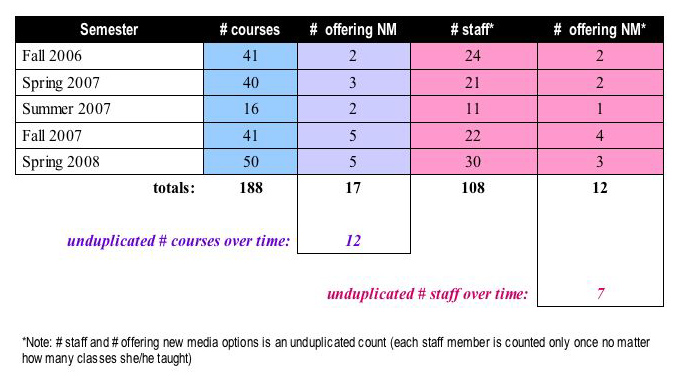



I also performed an unduplicated count of courses and instructors to derive a better sense of the new media composition opportunities available. As the table below demonstrates, only 12 discrete courses offered digital composition options according to the syllabi (lower than the original count of 17 because courses were offered repeatedly over the years studied). Similarly, in an unduplicated count, the number of discrete staff members explicitly announcing on their syllabi their willingness to accept new media compositions dropped to seven.

Of the 12 unduplicated courses offering digital media options, over half were new-media related classes (either revolving entirely around the subject or covering it as part of survey-course structure). Of those same 12 courses, seven also could be considered “production” courses specifically focused on producing specific types of genres/products — although not the same seven courses identified as new-media related. These data appear similar to findings in other studies. According to Anderson et al who conducted a survey of 45 faculty members and graduate students representing 25 college and universities:
Eighty-four percent of respondents (n=37) indicated that multimodality was taught on an “individual teacher basis” while only 32 percent reported that multimodality was taught in specific courses (rather than by specific teachers). On both undergraduate and graduate programmatic levels, 24 percent of respondents (n=9 in both cases, although not the same 9 respondents in each case) indicated that multimodality was emphasized as part of the curricula, and 21 percent (n=8) indicated that multimodality was implemented in general education sequences (2006b, 69).
Despite the fact that survey data from Anderson et al are not all specific to graduate classrooms, the numbers are similar to those collected for the Old Dominion University sample where options for new media assignments (multimodality in practice) are confined to a discrete number of courses and staff members. (It is important to keep in mind the limitations associated with analysis of this data.) In the case of ODU, there may be several factors contributing to this dearth. Given the nascent state of the doctoral program, the English Department may not be staffed appropriately to offer more new-media related courses. Additionally, more than one-third of the 800-level courses (five out of 14) are core courses for the doctoral program and the current emphasis may be placed on ensuring availability of those core requirements.
Despite these challenges, if an institutional priority is to be demonstrated regarding the production of new media scholarship, opportunities to produce digital compositions must be increased. Doing so will require that ODU faculty and English Studies faculty at other colleges and universities overcome the concerns commonly cited when shying away from digital arguments.
New media at ODU • Limited opportunities • An unduplicated count • Works cited • Home